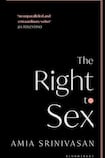
Amia Srinivasan is a “yes, and” thinker. Sex is private; yes, and our world shapes how we discuss it; yes, and there are gaps between what we say and what we do. The Right to Sex applies its author’s measured lens on “f**kability”, the limits of white and liberal feminism, the porn industry, how authority affects power in sexual relationships, and dimensions of moral accountability beyond the purely legal. But Srinivasan’s true subject is the need for nuance and generosity in contemporary discourse on sex. She demonstrates the value of clear thinking by testing it on a range of topics. You don’t need to agree with her on everything to admire her even-handedness, her commitment.
Stylistically I was reminded of What White People Can Do Next author Emma Dabiri’s wit: Srinivasan shares Dabiri’s gliding rigour and sharp edges. I fell apart laughing at “It is unclear how many men have died from women sitting on their faces” – I won’t give the context so it can surprise-amuse you too. It can jar when Srinivasan has multiple “friends of mine” appear in the same essay or even on the same page, but many less honest academics work anecdotally without saying so.
Srinivasan has a wide audience and can’t address everyone at once. If you’ve read anything on free speech, you’ll gloss over her “Fire!”-in-a-crowded-threatre analogy. Elsewhere she expects background knowledge, even within the same essay: “(It’s all very Valerie Solanas)”, she parenthesises, and only in the next chapter does she summarise Scum Manifesto. She defines “incel”, then assumes you’re au fait with “Chad”. I am, and would give anything not to be.
The Right to Sex considers lesbians mainly for what they have to say to straight women, and bisexuals precisely once – as capable of hitting on both male and female students
The Right to Sex draws cross-cultural parallels, mainly between the US, the UK and India, in a bid to identify patterns while respecting local context. Accusations of rape against black men in the US and Dalit men in India illustrate a common principle without flattening the particularities of either case. Inevitably, though, Srinavasan is more exacting at some points than others. “Talking to My Students About Porn” leaves it unclear whether 1970s backlash against porn was common among black feminists, since Srinivasan cites only two of them when examining this point. Disability features solely as a privilege-caveat; Srinivasan repeatedly calls others “able-bodied”, a term controversial within disabled communities as it makes many of us wonder how non-disabled people think we ought to look. This is not a purely semantic criticism (I find those tiresome, as I’m sure Srinivasan does): in a work that does not meaningfully incorporate disabled perspectives, I think it is better not to mention us at all than to do so tokenistically.

I also found the treatment of LGBT+ activism woven a little too neatly into a general narrative of feminist achievement. The Right to Sex considers lesbians mainly for what they have to say to straight women, and bisexuals precisely once – as capable of hitting on both male and female students. Srinivasan is right to state that cisgender lesbians are capable of transphobia, but she omits that so are all cis people; she might have better allocated her attention to trans lesbian perspectives, rather than spending as long as she does on trans-exclusionary cis ones. Meanwhile, gay men (“even the beautiful, white, rich, able-bodied ones”) are congratulated for their self-scrutiny. “[E]veryday heterosexual desire is erotically underscored by the professor-student dynamic”, we’re told, without apparent curiosity as to how or why it might be different for queers. And if Srinivasan thinks only “fem” men like to be bent over then her friend circle is vastly different from mine.
But if you approached Srinivasan at a conference, say, with such reservations, her vigorous writing convinces me that she’d answer with care, then ask: what do you think? She takes her opponents at their strongest, she braves ambiguity, and she holds up contradictory evidence to see if her argument still works.
For her, “there are two sides” doesn’t mean “let’s never conclude anything”, but “let’s consider a range of angles and surmise what we can”.
She cuts low-hanging fruit swiftly (“If you can ‘never really know’ whether Weinstein is a criminal or the victim of an elaborate set-up, then you likewise cannot know the same about, say, Bernie Madoff”) but gives thoughtful objections a thoughtful response. She is dauntless about the potential scrutiny of people who read books primarily to tweet screenshots. You will not find each paragraph pegged with qualifiers intended to debar you from making her look bad.
When reviewing a book I liked, I try to consider why someone else might not enjoy it. I owe you that courtesy since none of us have endless time and money (though I understand Elon Musk is working on both). Believe me, I’ve thoroughly audited why anyone should skip The Right to Sex, and I couldn’t think of any reasons. Srinavasan’s work is too interesting to be perfect. It’s superb.












